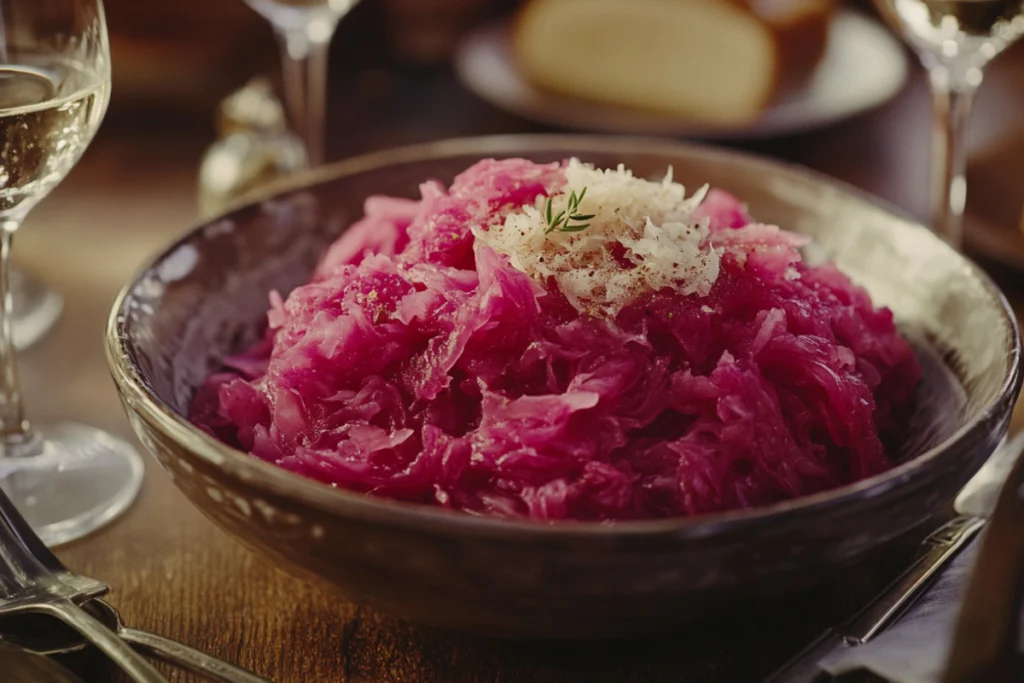
Red cabbage is not only a visually appealing vegetable but also a versatile one that can enhance a variety of dishes with its unique taste and nutritional profile. In this comprehensive guide, we will delve into what pairs well with red cabbage, exploring classic and modern pairings, preparation methods, and frequently asked questions.
Classic Pairings for Red Cabbage
Red cabbage has been used in traditional European recipes for centuries due to its vibrant color and slightly peppery taste. Here are some classic pairings:
1. Red Cabbage and Apples
One of the most loved combinations is red cabbage with apples. This pairing works well because the sweetness of apples balances the earthy bitterness of cabbage. Whether used in a braised red cabbage dish or added to a fresh salad, apples provide a delightful contrast.
- How to Prepare: Braise sliced red cabbage with thinly sliced apples, a bit of apple cider vinegar, and a pinch of cinnamon for a warming side dish.
2. Red Cabbage and Pork
The combination of red cabbage and pork is classic in many German and Central European dishes. The robust flavor of pork complements the sharpness of red cabbage beautifully. For inspiration, visit the Ultimate Guide to Red Cabbage Recipes for more recipes.
- Recipe Tip: Sauté red cabbage with onions and a splash of red wine, then serve alongside roasted pork chops for a hearty meal.
3. Vinegar-Based Dressings
Pickled red cabbage is a beloved side dish that adds a tangy touch to meals. The acidity of vinegar enhances the natural flavor of cabbage, making it a popular choice for tacos, sandwiches, and more. Learn about the shelf life and storage of pickled cabbage in How Long Does Red Cabbage Last in the Fridge.
- Quick Pickle Recipe: Mix shredded red cabbage with apple cider vinegar, sugar, and salt, then let it sit for a few hours.
Modern and Global Combinations
Red cabbage can easily be adapted to modern and global cuisines, offering flexibility for a range of culinary styles.
1. Middle Eastern Dishes
In Middle Eastern cuisine, red cabbage adds a crunchy texture to salads such as Salatet Malfouf. When combined with a lemon and garlic dressing, it pairs well with grilled chicken or lamb.
- Serving Suggestion: Serve a red cabbage salad with a plate of hummus, flatbread, and grilled meats for a balanced meal.
2. Asian-Inspired Dishes
Red cabbage can be a great addition to Asian stir-fries. Its vibrant color and texture complement ingredients like sesame oil, soy sauce, and ginger.
- Stir-Fry Idea: Sauté sliced red cabbage with julienned carrots, a dash of soy sauce, and a sprinkle of sesame seeds for a quick side dish.
3. Mediterranean Pairings
For those who love Mediterranean cuisine, pairing red cabbage with grilled fish or lamb can elevate your meal. The crunchiness of raw or lightly sautéed cabbage contrasts well with the tender meat and adds a refreshing component to the plate.
- Enhancement Tip: Top your cabbage salad with a spoonful of tzatziki or a squeeze of lemon juice for an added burst of flavor.
4. Kielbasa and Red Cabbage
For a hearty meal, consider serving red cabbage with kielbasa. The smoky and savory flavor of kielbasa enhances the cabbage’s natural taste, making it a perfect match. For more pairings, explore What Pairs Well with Kielbasa.
Best Methods to Prepare Red Cabbage
1. Braising
Braising red cabbage with ingredients like apples, onions, and red wine brings out a sweet and savory depth of flavor. This method is often used in German-style dishes such as Rotkohl.
- How to Braise: Cook shredded red cabbage with sliced apples, onions, and a mix of red wine and broth over low heat for 30–45 minutes.
2. Pickling
Pickled red cabbage is a versatile condiment that can be used in sandwiches, salads, or as a side dish. The pickling process is simple and helps preserve the cabbage for extended periods.
- Pickling Basics: Combine shredded cabbage with vinegar, sugar, and salt, and let it ferment for at least a day.
3. Roasting
Roasting red cabbage wedges with a drizzle of olive oil and your choice of seasoning creates a caramelized flavor that’s hard to beat.
- Roasting Tip: Add a sprinkle of cumin seeds and a touch of balsamic vinegar before roasting for a sweet and smoky result.
4. Raw Uses in Salads
Red cabbage can be used raw in salads to add a vibrant crunch. Combine it with shredded carrots, thinly sliced bell peppers, and a citrus vinaigrette for a refreshing side.
- Pro Tip: Let the salad sit for 15–20 minutes after dressing it to soften the cabbage slightly.
Flavor Pairings and Add-Ons
1. Herbs and Spices
Enhance the taste of red cabbage with the following herbs and spices:
- Caraway seeds for a nutty, earthy flavor.
- Dill for a fresh, tangy touch.
- Cloves for a hint of warm spice in braised dishes.
2. Complementary Proteins
Red cabbage goes well with proteins such as:
- Grilled fish or salmon.
- Roasted chicken.
- Sausages with a touch of garlic or spice.
3. Popular Seasonings
Try these seasonings to elevate your red cabbage dishes:
- Balsamic vinegar for a touch of sweetness.
- Apple cider vinegar for brightness.
- Citrus zest for a refreshing finish.
Nutritional Benefits of Red Cabbage
Red cabbage isn’t just versatile; it’s also packed with nutrients. It is a great source of vitamin C, vitamin K, and antioxidants, which help support immune function and digestion. Including red cabbage in your diet can promote overall health and well-being.
FAQs
Q1: What meats pair best with red cabbage?
Red cabbage pairs well with pork, chicken, and grilled fish, as these proteins enhance its earthy flavors.
Q2: Can red cabbage be eaten raw?
Yes, red cabbage can be eaten raw in salads or as a crunchy topping for burgers and tacos.
Q3: What spices go well with cooked red cabbage?
Caraway seeds, cloves, and dill are commonly used to enhance the flavor of cooked red cabbage.
Q4: How long does red cabbage last after being prepared?
Cooked red cabbage can be stored in an airtight container in the fridge for up to 5 days. For more tips on preserving red cabbage, visit How Long Does Red Cabbage Last in the Fridge.
Conclusion
From classic combinations with apples and pork to modern, globally inspired dishes, red cabbage is a versatile ingredient that can be used in a variety of ways. Whether you prefer it braised, pickled, roasted, or raw, this vibrant vegetable adds a delicious crunch and a burst of color to your meals. Experiment with these pairings and preparation methods to make the most out of red cabbage in your cooking repertoire.
